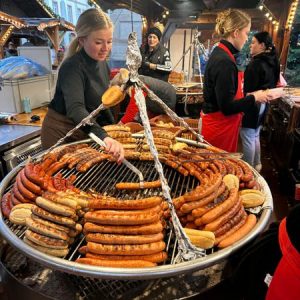Some months ago I decided to visit Rouen. This city is the capital of Normandy in France. I was fortunate to receive a guided tour from a member of the local tourist office. This is based in the City centre, right in front of the Notre Dame Cathedral. The very first impression that struck me was the certainty that I was in France. The intricate detail of the Gothic architecture coupled with the half timbered medieval street houses could not have blended together so well in any other country on earth. I met up with Miriam, my guide. She had an encyclopedic knowledge of the history, affairs and architecture of Rouen. She was as French as the City itself.
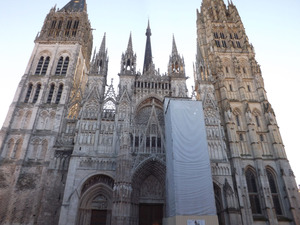 My visit began at the great cathedral. There cannot be an ecclesiastical structure more photogenic anywhere else in Europe. Monet, the great impressionist artist, had painted Notre Dame over 30 times up until 1894. Many of his ‘sittings’ took place from a room in what is now the tourist office. Look up at the first floor and find the easel that is still there, just by the window. The style of Monet’s work had little to do with Christianity however. He wanted to project the colour and light of all things that sustain human life itself in the vivacious new age of impressionism. That epoch of art is just as vibrant today and all can find it for themselves.
My visit began at the great cathedral. There cannot be an ecclesiastical structure more photogenic anywhere else in Europe. Monet, the great impressionist artist, had painted Notre Dame over 30 times up until 1894. Many of his ‘sittings’ took place from a room in what is now the tourist office. Look up at the first floor and find the easel that is still there, just by the window. The style of Monet’s work had little to do with Christianity however. He wanted to project the colour and light of all things that sustain human life itself in the vivacious new age of impressionism. That epoch of art is just as vibrant today and all can find it for themselves.
In the summer months, 21st century digital technology is used to shine and project the history of Rouen against the west face of the City’s Notre Dame Cathedral. It is there for all passing visitors to see. The wide space spreading out in front provides an uninterrupted view. The light and sound show will astonish the viewer. It covers the whole vastness of the cathedral frontage in clear and penetrating light in the form of a visual exhibition. One of the displays is called ‘First Impressions’ and stems from the artistic period that has such close association with Normandy. The nightly son et lumiere depicts a fishing trip, scenes of a young girl on a swing and many other representations from the great artistic works of the impressionist period. Sounds include those of laughing children and conversation from the nineteenth century. All of the imagery is overwhelming and seems to have found a particular renaissance emerging from the very womb of the cathedral.
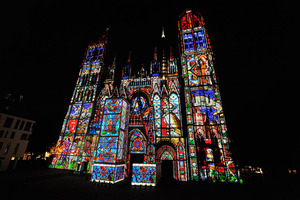 Another of the illuminated exhibits projects the life of Saint Joan of Arc. Her whole history is entrenched in the cultural roots of Rouen. The light and sound presentation projects all of Joan’s life from her birth to her final execution at the burning stake in Rouen. That took place on May 30th, 1431. The sound creates a tender yet intensely passionate narration of Joan’s contribution to French history and culture. It ends with the powerful sound of her beating heart getting louder and louder as she bravely faces her imminent death from the fierce fires.
Another of the illuminated exhibits projects the life of Saint Joan of Arc. Her whole history is entrenched in the cultural roots of Rouen. The light and sound presentation projects all of Joan’s life from her birth to her final execution at the burning stake in Rouen. That took place on May 30th, 1431. The sound creates a tender yet intensely passionate narration of Joan’s contribution to French history and culture. It ends with the powerful sound of her beating heart getting louder and louder as she bravely faces her imminent death from the fierce fires.
Rouen cathedral has become engulfed in the projection of its city’s history. The spirit of the light on the church walls also bring a re-birth for the once so radiantly painted external sculptures. Many of them remain in place on the structure.
I moved on with Miriam to visit the Saint Maclou church, just a short distance along the rue St. Romain. This church is one of the most imposing examples of classic Gothic architecture anywhere. It was badly damaged by both enemy and allied hostile activities in World War 2 and its restoration was only completed in 2013.
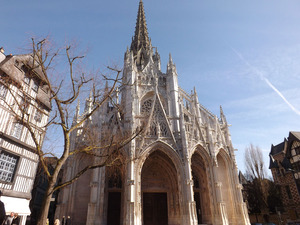 Saint Maclou church seems to consciously scrutinise all that lies beneath it. The edifice appears as though a form of mythical Gothic crystal has just sprung up from the surrounding earth. Somehow, it has imposed its particular overbearing dominance of all that it surveys. Modern restoration and reconstruction methods have re-produced once more the glories of half a millennium ago for all to embrace. The surrounding space around St. Maclou is reserved for public dining and relaxation. I sat there myself drinking a beer and just marvelled at the Gothic perfection that stared back at me.
Saint Maclou church seems to consciously scrutinise all that lies beneath it. The edifice appears as though a form of mythical Gothic crystal has just sprung up from the surrounding earth. Somehow, it has imposed its particular overbearing dominance of all that it surveys. Modern restoration and reconstruction methods have re-produced once more the glories of half a millennium ago for all to embrace. The surrounding space around St. Maclou is reserved for public dining and relaxation. I sat there myself drinking a beer and just marvelled at the Gothic perfection that stared back at me.
Just behind the church, visitors can find the Aitre St. Maclou, an ancient cemetery dating back to the black death of 1348. This is a rather moribund place to visit and still bears the signs of crumbling graves. There are carvings of skulls and tibias on the buildings. Visitors come here to almost contemplate death itself. The associated rooms were later used as a boarding school for girls and, then afterwards, as the Le Havre Regional School of Art and Design.
I wandered through the streets with Miriam learning so much more about Rouen. Medieval architecture has been preserved here using the most modern methods. There are more than 2000 original half- timbered houses in the City. Around 200 of them date back to the middle ages. They blend easily with the grandest of structures and create a municipal culture almost unique to Normandy. Most of the properties are protected by local bylaws and yet are rented as houses for everyday use.
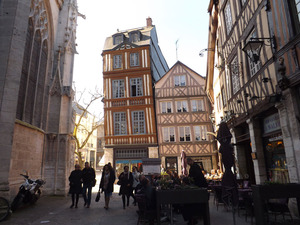 We arrived at the Abbey Saint Ouen. The similarity of the name to the City is apparently coincidental. This is a vast cathedral standing in its own garden area. Inside, the sense is of such monumental space and light. A building designed and constructed nowadays surely could not create such vastness that came from ancient medieval architecture. This abbey, though humbler in design, is even bigger than the Notre Dame Cathedral itself. Behind it stands the equally splendid Hotel de Ville.
We arrived at the Abbey Saint Ouen. The similarity of the name to the City is apparently coincidental. This is a vast cathedral standing in its own garden area. Inside, the sense is of such monumental space and light. A building designed and constructed nowadays surely could not create such vastness that came from ancient medieval architecture. This abbey, though humbler in design, is even bigger than the Notre Dame Cathedral itself. Behind it stands the equally splendid Hotel de Ville.
My tour moved back again towards Rouen city centre. We arrived at the Palace of Justice. This building used to be the place of the Parliament of Normandy. Nowadays it is a principal court of the region. In 1976, a major Jewish monument was discovered under the palace courtyard that dates back to the 12th century. The entrance to this place is named in Hebrew and translates as ’Sublime Abode.’ Even now, archaeologists are not certain whether it was a college or a synagogue. It was, perhaps, the residence of a wealthy merchant or trader. Separate guided tours are available. Jewish culture is a significant component of the history of Rouen.
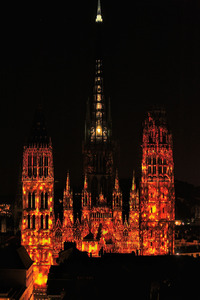 Miriam and I moved on passing the beautifully preserved and shining, gold faceted Gros Horloge. This is a functioning street clock that symbolises the great city wealth created by the powerful wool industry that was so vibrant in past centuries. The panoramic view of all of Rouen from the top of the belfry is truly an extraordinary sight. We were heading for the brand new church standing on the place where Joan of Arc died.
Miriam and I moved on passing the beautifully preserved and shining, gold faceted Gros Horloge. This is a functioning street clock that symbolises the great city wealth created by the powerful wool industry that was so vibrant in past centuries. The panoramic view of all of Rouen from the top of the belfry is truly an extraordinary sight. We were heading for the brand new church standing on the place where Joan of Arc died.
Joan of Arc was a peasant girl living in medieval France. She believed that God had chosen her to lead France to victory during the hundred years’ war with the English. Her history is distinct and spiritually inspiring and Joan stands as perhaps the greatest French heroine of all time. She was tried by English and French collaborators in Rouen as a witch and a heretic. The sentence was that she should be burned at the stake in the town square. This took place in 1431 and she was just nineteen years old.
The ‘Place du Vieux Marche’ in Rouen immortalizes the event of Joan’s execution. The very location of the burning stake is marked with a towering, overlooking stone cross. A modern day church has been built in dedication of Joan of Arc at the same position. The architectural style is a little obscure and contemporary. The architect has made little comment about it other than leaving it to the imagination of the visitor. I thought that it resembled a large wooden fishing boat with all the Christian connotations that go with that. Visitors can make their own minds up.
The dungeon and courtroom where Joan was tried is still present. Twenty five years after her horrific death, she was exonerated of all crimes by the same court in the same building. Joan of Arc was canonized in 1920 and remains a great focus of unity for French people in times of crisis.
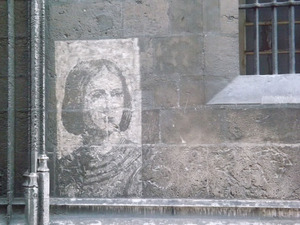 The courtroom building was opened early in the spring of 2015 as a museum dedicated to the life and history of Joan. The rooms are part of the Archbishops palace closely tied to the Notre Dame Cathedral complex. The museum features state of the art holograms representing the Saint. There are also 3D animations showing what real life was like in Rouen in the fifteenth century. History has been brought realistically back again in a new spirit.
The courtroom building was opened early in the spring of 2015 as a museum dedicated to the life and history of Joan. The rooms are part of the Archbishops palace closely tied to the Notre Dame Cathedral complex. The museum features state of the art holograms representing the Saint. There are also 3D animations showing what real life was like in Rouen in the fifteenth century. History has been brought realistically back again in a new spirit.
Later in the day, I visited alone the brand new and enormous Panorama XXL cinematic building. It lies on the banks of the Seine River that flows through Rouen on its way to the sea from Paris. This cinematic exhibition is rapidly evolving a totally contemporary art form. Currently it features a vast and breathtaking 360 degree panoramic scene from the period of the Roman Empire. Walk all the way round the elevated and lofty gallery. The sight will impress so many corners of your imagination. In the future, similar cinematic impressions of the Viking invasion, impressionist art and the life of Joan of Arc will be displayed in this vast and vivid form. The artist, Yadegar Asisi, has created a truly impressive spectacle.
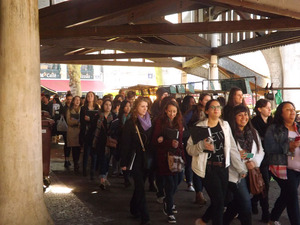 Rouen is home to all of the cultural aspects of French society that we are all so attracted to. There are many museums, art galleries and exhibitions to visit. There is always a lively Sunday Market in the centre selling almost everything.
Rouen is home to all of the cultural aspects of French society that we are all so attracted to. There are many museums, art galleries and exhibitions to visit. There is always a lively Sunday Market in the centre selling almost everything.
The quality of the gastronomy in the numerous restaurants is equal to anywhere in France. Rouen is a little different though. It has a history of commerce, wealth creation and patriotic symbolism greater than perhaps any other regional French city. It is bringing its illustrious past back to life using the splendours of contemporary digital technology in every sense. All is there for the modern visitor to see and marvel at. You are made to feel somehow a part of all that has gone before.

